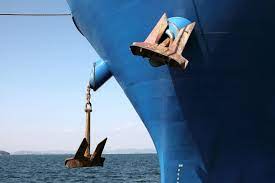
Anchoring is one of the very frequent operations on-board ships. A number of variables and external factors influence the duration and location of an anchoring operation. While the type of seabed is of utmost importance during anchoring, soft muddy grounds or clay bottoms are best preferred.
It should be taken care that the anchoring bottom is free of power lines, submarine cables, pipelines or rocks. Various methods on anchoring include consideration of direction and strength of wind, current and tidal stream. Often good local knowledge helps a mariner determine required manoeuvres and actions to be taken while anchoring.
The two most prevalent methods for anchoring are: Let Go and Walk Back under Power.
Let Go: This method is used in over a wide range of vessels including smaller crafts and pleasure yachts to larger vessels with tonnage varying up to 1,00,000 GT. The principle followed in this method is to let go or let the anchor slip with cable under its own weight from the hawse pipe. The weight on the cable, windlass brake holding power and momentum of the vessel are factors to be controlled by the vessel to ensure the anchor digs in and the cable is subsequently laid to extend backwards. While approaching the anchoring position the speed of the vessel over ground is brought to zero using engines and helm and at the same point anchor along with the cable is allowed to run out under its own weight.
Once the flukes touch the bottom or chain touches the ground the engines are moved astern or ahead according to the prevailing conditions of wind and current to attain astern momentum with respect to ground, which will stretch the cable. It can be paid under controlled application of brakes to control the length of cable from running out completely. Often under such conditions combined effects of wind and current vessel will tend to swing and fall astern as well.
Attention to be paid to the preferred direction of swing and the anchor on which side to be used. Care should also be taken to not allow the full cable to run out under weight or to allow the cable to pile up which can result is developing kink or twist in the cable. During approach to anchoring grounds it is a general practice by shipmasters to lower the anchor to water level so that when the brakes are released the cables is paid out freely.
After a long sea voyage sometimes the anchor might get stuck in hawse pipe and not release down from the hawse pipe under its own weight. As a proactive and good seamanship practice one should always check the condition of the windlass brake liner before use.
On several occasions, often on old ships, due to repeated use brake liners were found completely worn out or below required thickness, consequently reducing the braking power significantly which led to cable running out completely under its own weight resulting in loss of anchor and cable both.
Uneven loads or excessive astern momentum after applying brakes can damage the windlass and its seat and foundation. Engines should be used to counter the excessive momentum of the ship and the state of the vessel loaded or in ballast should be always kept in mind while using engines. Prolonged kicks might develop sufficient momentum in a loaded vessel to drag anchor or even snap the cable. A loaded vessel is found to be more responsive to effects of current or tide whereas a vessel in ballast drifts substantially due to wind. Combined effects and directions of local conditions can be helpful while doing preparation for anchoring.
Walk Back Method: Most of the companies have their own guidelines for anchoring large ships such as VLCC’S or ULCC’S which should be followed without fail. Walk back method of anchoring is recommended and used mostly on vessel’s above 1,00,000 GT.
The working principle is the same however cable is paid out using the windlass at a fixed speed. Upon approaching the anchoring position the speed upon ground of the vessel is brought gradually to zero and the anchor is lowered in water.
As it touches the bottom more length is paid and engines are given astern to develop slight astern movement to lay the cable nicely as the flukes of the anchor dig in the seabed. This method usually is of longer duration than the let go method; however it provides ship master’s with better control over the amount of cable paid and weight upon the windlass. It is important that correct assessment beforehand of tidal conditions, gusty winds or strong coastal currents are made by ship master to accommodate for the movement of vessel as the cable is paid out. In general design speed of windlass is about 30-35 feet/min., which is approximately 0.3 knots over the ground.
Also a windlass is designed to lift up to 3 -4 shackles along with the weight of the anchor. Walk back method prevents piling up or twisting of cable, which is paid under power and thus provides better control to master or pilot to ensure the anchor holds in and does not drag. However speed over ground of vessel must be diligently controlled to avoid excessive loads on windlass, which is being used with gear engaged.















